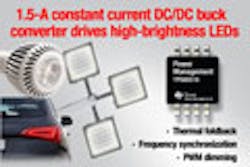The TPS92510, a 1.5 A constant current dc/dc buck converter from Texas Instruments drives high-brightness LEDs. Touting an industry-leading combination of frequency synchronization, PWM, dimming and thermal foldback, the converter also features a 3.5 V to 60 V input voltage operating range and integrated MOSFET. Together with the company's WEBENCH LED Architect, the lighting developer can design a power management circuit to drive a string of up to 17 high-brightness LEDs at up to 97% power efficiency in automotive, industrial and general illumination applications. The TPS92510 operates with fixed frequency either by utilizing its internally-generated clock or via synchronization to an external PWM clock source. In multi-string implementations, the use of an external clock eliminates beat frequencies that may be visible in the lighting application and simplifies EMI filter design. Thermal foldback ensures some light output remains even in an LED over-temperature condition to improve safety. The TPS92510 is available now in a 4.9 x 3 mm, 10-pin PowerPad MSOP package and is priced at $1.65 each/1,000.
About the Author
Staff
Articles, galleries, and recent work by members of Electronic Design's editorial staff.
Sign up for our eNewsletters
Get the latest news and updates
Voice Your Opinion!
To join the conversation, and become an exclusive member of Electronic Design, create an account today!
Sponsored Picks
Sponsored
